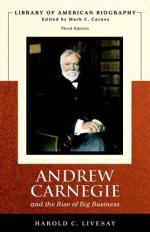|
This section contains 563 words (approx. 2 pages at 400 words per page) |

|
The Apprentice Financier Summary and Analysis
Carnegie rises from bobbin boy at $1.20 per week in 1850 to railroad superintendent at $2,400 per year in 1865. In 1856 Scott advises him to buy Adams Express Company as his first stock investment. Carnegie's first dividend check for $10 opens a whole new world of receiving cash from capital. In 1863, his investments pay $45,460 and by 1868, he receives $56,110 per year for an investment of $817 that he borrows to make. By the age of twenty-eight Carnegie manages a complex, multi-unit industrial enterprise and capitalizes on knowing the value of money based on what it can earn.
Carnegie is cautious in his investments by limiting them to firms he knows about that are related to the Pennsylvania Railroad. He forms an informal investing triumvirate with Thomson and Scott. For example, Scott and Thomson like the Woodruff Sleeping Car Company that owns patents in 1858 but...
(read more from the The Apprentice Financier Summary)
|
This section contains 563 words (approx. 2 pages at 400 words per page) |

|




